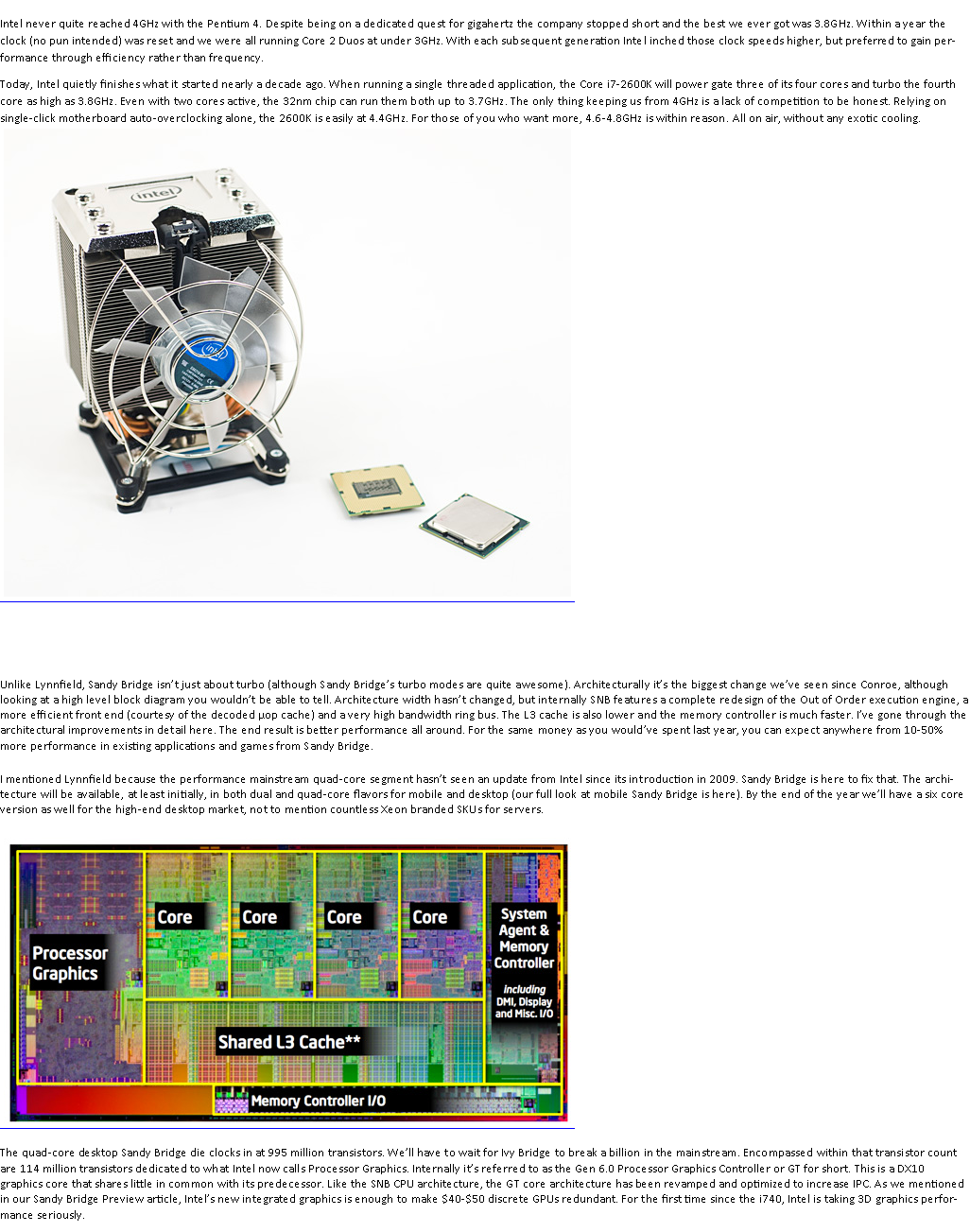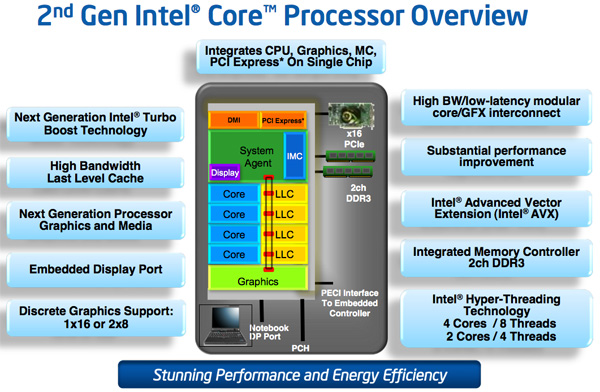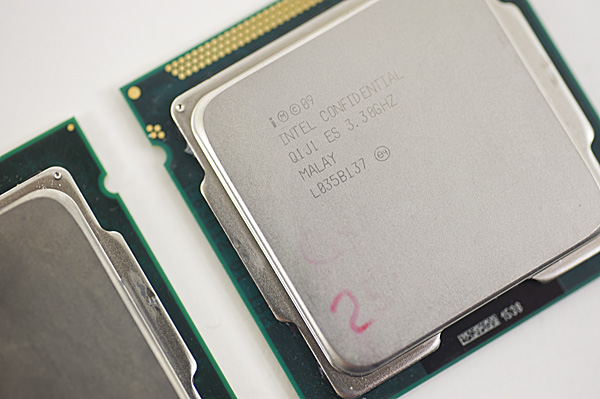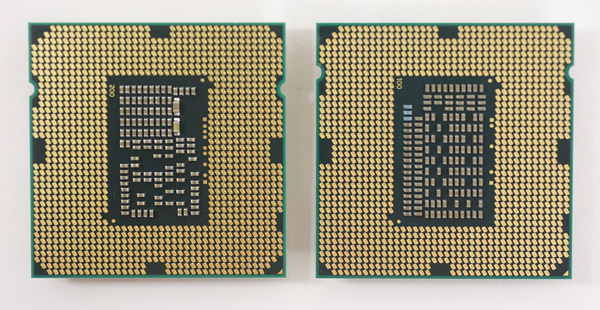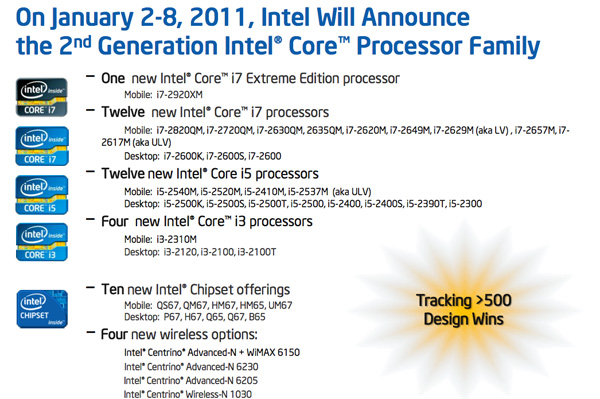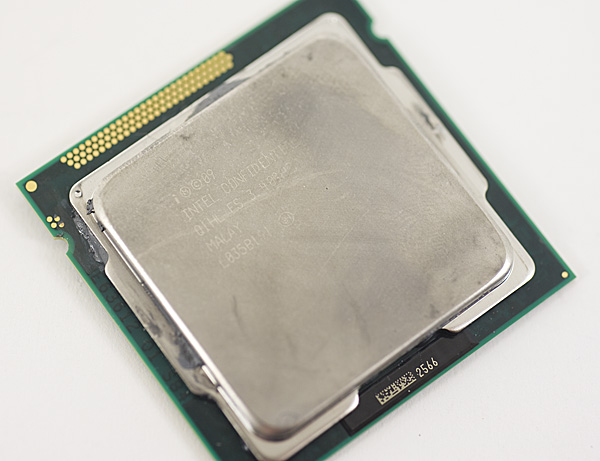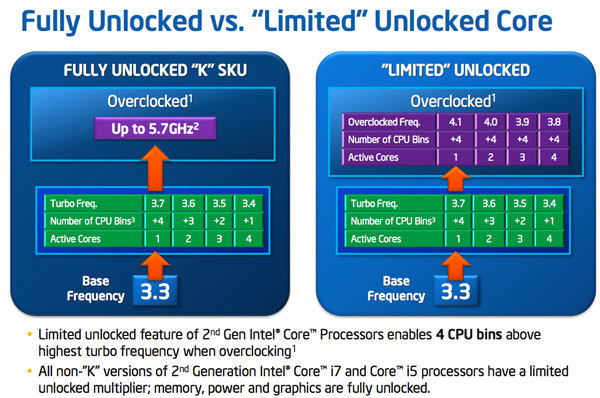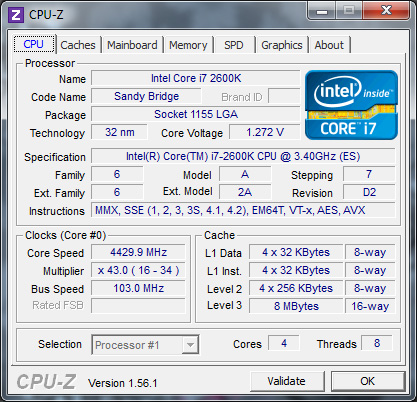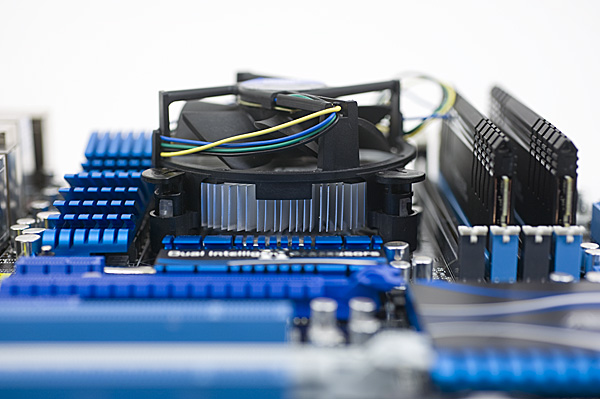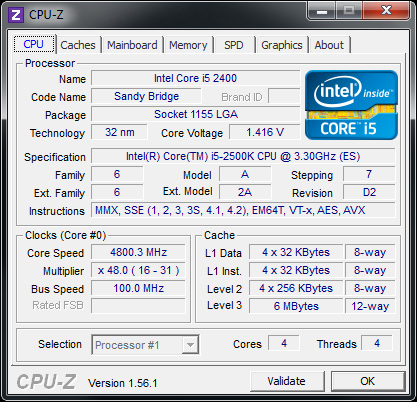|
by Anand Lal Shimpi |
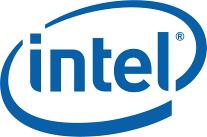

|
TopNax |
The LineupI don’t include a lot of super markety slides in these launch reviews, but this one is worthy of a mention:
Sandy Bridge is launching with no less than 29 different SKUs today. That’s 15 for mobile and 14 for desktop. Jarred posted his full review of the mobile Core i7-2820QM, so check that out if you want the mobile perspective on all of this. By comparison, this time last year Intel announced 11 mobile Arrandale CPUs and 7 desktop parts. A year prior we got Lynnfield with 3 SKUs and Clarksfield with 3 as well. That Sandy Bridge is Intel’s biggest launch ever goes without saying. It’s also the most confusing. While Core i7 exclusively refers to processors with 4 or more cores (on the desktop at least), Core i5 can mean either 2 or 4 cores. Core i3 is reserved exclusively for dual-core parts. Intel promised that the marketing would all make sense one day. Here we are, two and a half years later, and the Core i-branding is no clearer. At the risk of upsetting all of Intel Global Marketing, perhaps we should return to just labeling these things with their clock speeds and core counts? After all, it’s what Apple does—and that’s a company that still refuses to put more than one button on its mice. Maybe it’s worth a try. Check Jarred’s article out for the mobile lineup, but on desktop here’s how it breaks down: |
|
Intel is referring to these chips as the 2nd generation Core processor family, despite three generations of processors carrying the Core architecture name before it (Conroe, Nehalem, and Westmere). The second generation is encapsulated in the model numbers for these chips. While all previous generation Core processors have three digit model numbers, Sandy Bridge CPUs have four digit models. The first digit in all cases is a 2, indicating that these are “2nd generation” chips and the remaining three are business as usual. I’d expect that Ivy Bridge will swap out the 2 for a 3 next year.
What you will see more of this time around are letter suffixes following the four digit model number. K means what it did last time: a fully multiplier unlocked part (similar to AMD’s Black Edition). The K-series SKUs are even more important this time around as some Sandy Bridge CPUs will ship fully locked, as in they cannot be overclocked at all (more on this later). |
|
There are also T and S series parts for desktop. These are mostly aimed at OEMs building small form factor or power optimized boxes. The S stands for “performance optimized lifestyle” and the T for “power optimized lifestyle”. In actual terms the Ses are lower clocked 65W parts while the Ts are lower clocked 35W or 45W parts. Intel hasn’t disclosed pricing on either of these lines but expect them to carry noticeable premiums over the standard chips. There’s nothing new about this approach; both AMD and Intel have done it for a little while now, it’s just more prevalent in Sandy Bridge than before. More DifferentiationIn the old days Intel would segment chips based on clock speed and cache size. Then Intel added core count and Hyper Threading to the list. Then hardware accelerated virtualization. With Sandy Bridge the matrix grows even bigger thanks to the on-die GPU. |
|
While almost all SNB parts support VT-x (the poor i3s are left out), only three support VT-d. Intel also uses AES-NI as a reason to force users away from the i3 and towards the i5. I’ll get into the difference in GPUs in a moment. |
Overclocking, the K-Series and What You’ll Want to BuyIf you haven’t noticed, the computing world is becoming more integrated. We review highly integrated SoCs in our smartphone coverage, and even on the desktop we’re seeing movement towards beefy SoCs. AMD pioneered the integrated memory controller on desktop PCs, Intel followed suit and with Lynnfield brought a PCIe controller on-die as well. Sandy Bridge takes the next logical step and brings a GPU on-die, a move matched by AMD with Brazos and Llano this year. In the spirit of integration, Intel made one more change this round: the 6-series chipsets integrate the clock generator. What once was a component on the motherboard, the PLL is now on the 6-series chipset die. The integrated PLL feeds a source clock to everything from the SATA and PCIe controllers to the SNB CPU itself. With many components driven off of this one clock, Intel has locked it down pretty tight. With Nehalem and Westmere, to overclock you simply adjusted the BCLK from 133MHz to whatever speed you wanted and sometimes toyed with multipliers to arrive at a happy end result. With Sandy Bridge, the BCLK generated on the 6-series PCH is at 100MHz by default and honestly won’t go much higher than that. While I’ve heard reports of getting as high as 115MHz, I’d view 103—105MHz as the upper limit for what you’re going to get out of BCLK overclocking. In other words: next to nothing. A 105MHz BCLK overclock on a Core i7-2600 will take you from a stock speed of 3.4GHz to a whopping 3.57GHz. The form of overclocking we’ve been using for the past decade is effectively dead on Sandy Bridge. Years ago, before the Pentium II, we didn’t rely on BCLK (or back then it was just FSB or bus overclocking) to overclock. Back then, if we wanted a faster CPU we’d just increase the clock multiplier. Intel has dabbled in offering multiplier unlocked parts for overclockers, we saw this last year with the Core i7 875K for example. With Sandy Bridge, those unlocked parts are going to be a lot more important to overclockers. It works like this. If you have a part that does not support Turbo (e.g. Core i3-2100 series), then your CPU is completely clock locked. You can’t overclock it at all, have fun at your stock frequency. This is good news for AMD as it makes AMD even more attractive at those price points. If you have a part that does support turbo (e.g. Core i5-2400), then you have what’s called a “limited unlocked” core—in other words you can overclock a little bit. These parts are limited to an overclock of 4 processor bins above and beyond the highest turbo frequency. Confused yet? This chart may help: In this case we’re looking at a Core i5-2500, which runs at 3.3GHz by default. When a single core is active, the chip can turbo up to 3.7GHz. If you want, you can change that turbo state to go as high as 4.1GHz (if your CPU and cooling can keep up). Overclocking these limited unlocked chips relies entirely on turbo however. In the case above, the fastest your chip will run is 4.1GHz but with only one core active. If you have four cores active the fastest your chip can run is 3.8GHz. While Intel didn’t sample any limited unlocked parts, from what I’ve heard you shouldn’t have any problems hitting these multiplier limits. There’s a third class of part: a fully unlocked K-series chip. At launch there are only two of these processors: the Core i5-2500K and the Core i7-2600K. Anything with a K at the end of it means you get all multipliers from 16x all the way up to 57x at your disposal. It’s effectively fully unlocked.
These chips overclock very well. Both my Core i5-2500K and Core i7-2600K hit ~4.4GHz, fully stable, using the stock low-profile cooler.
With a bit more effort and a better cooler, you can get anywhere in the 4.6-5.0GHz range:
It's a bit too early to tell how solid these near-5GHz overclocks will be, but I'm confident in the sub-4.5GHz overclocks we were able to sustain. You do pay a price premium for these K-series SKUs. The 2500K will cost you another $11 over a stock 2500 and the 2600K costs an extra $23. In the case of the 2500K, that’s a small enough premium that it’s honestly worth it. You pay $11 extra for a chip that is very conservatively clocked and just begging for you to overclock it. Even the 2600K’s premium isn’t bad at all. |
|
As an added bonus, both K-series SKUs get Intel’s HD Graphics 3000, while the non-K series SKUs are left with the lower HD Graphics 2000 GPU. Compared to Lynnfield, you’re paying $11 more than a Core i5-760 and you’re getting around 10-45% more performance, even before you overclock. In a perfect world I’d want all chips to ship unlocked; in a less perfect world I’d want there to be no price premium for the K-series SKUs, but at the end of the day what Intel is asking for here isn’t absurd. On the bright side, it does vastly simplify Intel’s product stack when recommending to enthusiasts: just buy anything with a K at the end of it. Since we’re relying on multiplier adjustment alone for overclocking, your motherboard and memory actually matter less for overclocking with Sandy Bridge than they did with P55. On both P67 and H67, memory ratios are fully unlocked so you can independently set memory speed and CPU speed. Even the GPU ratios are fully unlocked on all platforms and fully independent from everything else. |
|
Processor |
Core Clock |
Cores / Threads |
L3 Cache |
Max Turbo |
Max Overclock Multiplier |
TDP |
Price |
|
Intel Core i7-2600K |
3.4GHz |
4 / 8 |
8MB |
3.8GHz |
57x |
95W |
$317 |
|
Intel Core i7-2600 |
3.4GHz |
4 / 8 |
8MB |
3.8GHz |
42x |
95W |
$294 |
|
Intel Core i5-2500K |
3.3GHz |
4 / 4 |
6MB |
3.7GHz |
57x |
95W |
$216 |
|
Intel Core i5-2500 |
3.3GHz |
4 / 4 |
6MB |
3.7GHz |
41x |
95W |
$205 |
|
Intel Core i5-2400 |
3.1GHz |
4 / 4 |
6MB |
3.4GHz |
38x |
95W |
$184 |
|
Intel Core i5-2300 |
2.8GHz |
4 / 4 |
6MB |
3.1GHz |
34x |
95W |
$177 |
|
Intel Core i3-2120 |
3.3GHz |
2 / 4 |
3MB |
N/A |
N/A |
65W |
$138 |
|
Intel Core i3-2100 |
2.93GHz |
2 / 4 |
3MB |
N/A |
N/A |
65W |
$117 |
|
Processor |
Core Clock |
Cores / Threads |
L3 Cache |
Max Turbo |
TDP |
|
Intel Core i7-2600S |
2.8GHz |
4 / 8 |
8MB |
3.8GHz |
65W |
|
Intel Core i5-2500S |
2.7GHz |
4 / 4 |
6MB |
3.7GHz |
65W |
|
Intel Core i5-2500T |
2.3GHz |
4 / 4 |
6MB |
3.3GHz |
45W |
|
Intel Core i5-2400S |
2.5GHz |
4 / 4 |
6MB |
3.3GHz |
65W |
|
Intel Core i5-2390T |
2.7GHz |
2 / 4 |
3MB |
3.5GHz |
35W |
|
Intel Core i5-2100T |
2.5GHz |
2 / 4 |
3MB |
N/A |
35W |
|
Processor |
Intel HD Graphics |
Graphics Max Turbo |
Quick Sync |
VT-x |
VT-d |
TXT |
AES-NI |
|
Intel Core i7-2600K |
3000 |
1350MHz |
Y |
Y |
N |
N |
Y |
|
Intel Core i7-2600 |
2000 |
1350MHz |
Y |
Y |
Y |
Y |
Y |
|
Intel Core i5-2500K |
3000 |
1100MHz |
Y |
Y |
N |
N |
Y |
|
Intel Core i5-2500 |
2000 |
1100MHz |
Y |
Y |
Y |
Y |
Y |
|
Intel Core i5-2400 |
2000 |
1100MHz |
Y |
Y |
Y |
Y |
Y |
|
Intel Core i5-2300 |
2000 |
1100MHz |
Y |
Y |
N |
N |
Y |
|
Intel Core i3-2120 |
2000 |
1100MHz |
Y |
N |
N |
N |
N |
|
Intel Core i3-2100 |
2000 |
1100MHz |
Y |
N |
N |
N |
Y |
|
Model Number |
Standard SKU |
K-Series SKU |
Price Premium |
|
Intel Core i7-2600 |
$294 |
$317 |
+$23 |
|
Intel Core i5-2500 |
$205 |
$216 |
+$11 |
